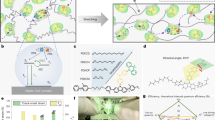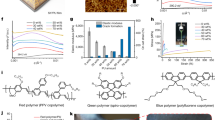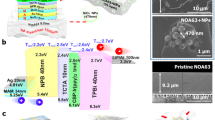Abstract
Stretchable displays that can change their shape and size under strain could be used to create displays with unconventional form factors. However, intrinsically stretchable light-emitting devices have poor luminous performance, such as low brightness. Here we show that intrinsically stretchable quantum dot light-emitting diodes (QLEDs) can be made using a mechanically soft and stretchable emissive layer consisting of a ternary nanocomposite of colloidal quantum dots, an elastomeric polymer and a charge transport polymer. The light-emitting layer maintains a nearly constant interparticle distance even under 50% strain, ensuring reliable operation of the QLED under stretching. The polymer-rich charge transport region at the bottom of the nanocomposite functions as a hole transport pathway to the embedded quantum dots. The QLEDs exhibit a turn-on voltage of 3.2 V and a maximum luminance of 15,170 cd m−2 at 6.2 V without loss of brightness, even when under 50% strain, and can be used to make stretchable full-colour passive-matrix QLED arrays.
This is a preview of subscription content, access via your institution
Access options
Access Nature and 54 other Nature Portfolio journals
Get Nature+, our best-value online-access subscription
$29.99 / 30 days
cancel any time
Subscribe to this journal
Receive 12 digital issues and online access to articles
$119.00 per year
only $9.92 per issue
Buy this article
- Purchase on Springer Link
- Instant access to full article PDF
Prices may be subject to local taxes which are calculated during checkout





Similar content being viewed by others
Data availability
The data that support the plots within this paper and other findings of this study are available from the corresponding authors upon reasonable request.
Code availability
The source codes for Arduino 1.8.3 are available from the corresponding authors upon reasonable request.
References
Choi, M. K., Yang, J., Hyeon, T. & Kim, D.-H. Flexible quantum dot light-emitting diodes for next-generation displays. npj Flex. Electron. 2, 10 (2018).
Choi, M. et al. Full-color active-matrix organic light-emitting diode display on human skin based on a large-area MoS2 backplane. Sci. Adv. 6, abb5898 (2020).
Kim, D. C. et al. Three-dimensional foldable quantum dot light-emitting diodes. Nat. Electron. 4, 671–680 (2021).
Sekitani, T. et al. Stretchable active-matrix organic light-emitting diode display using printable elastic conductors. Nat. Mater. 8, 494–499 (2009).
Koo, J. H., Kim, D. C., Shim, H. J., Kim, T.-H. & Kim, D.-H. Flexible and stretchable smart display: materials, fabrication, device design, and system integration. Adv. Funct. Mater. 28, 1801834 (2018).
Zhang, Z. et al. High-brightness all-polymer stretchable LED with charge-trapping dilution. Nature 603, 624–630 (2022).
Kim, D. C. et al. Material-based approaches for the fabrication of stretchable electronics. Adv. Mater. 32, 1902743 (2020).
Yin, H. et al. Structures and materials in stretchable electroluminescent devices. Adv. Mater. 34, 2106184 (2022).
Cho, K. W. et al. Soft bioelectronics based on nanomaterials. Chem. Rev. 122, 5068–5143 (2022).
Yu, Z., Niu, X., Liu, Z. & Pei, Q. Intrinsically stretchable polymer light-emitting devices using carbon nanotube-polymer composite electrodes. Adv. Mater. 23, 3989–3994 (2011).
Liang, J., Li, L., Niu, X., Yu, Z. & Pei, Q. Elastomeric polymer light-emitting devices and displays. Nat. Photon. 7, 817–824 (2013).
Liu, Y. et al. A self-assembled 3D penetrating nanonetwork for high-performance intrinsically stretchable polymer light-emitting diodes. Adv. Mater. 34, 2201844 (2022).
Han, S. J. et al. Achieving low-voltage operation of intrinsically-stretchable organic light-emitting diodes. Adv. Funct. Mater. 33, 2211150 (2023).
Liu, J. et al. Fully stretchable active-matrix organic light-emitting electrochemical cell array. Nat. Commun. 11, 3362 (2020).
Kim, J.-H. & Park, J.-W. Intrinsically stretchable organic light-emitting diodes. Sci. Adv. 7, abd9715 (2021).
Zhou, H. et al. Graphene-based intrinsically stretchable 2D-contact electrodes for highly efficient organic light-emitting diodes. Adv. Mater. 34, 2203040 (2022).
Liu, W. et al. High-efficiency stretchable light-emitting polymers from thermally activated delayed fluorescence. Nat. Mater. 22, 737–745 (2023).
Jiang, D.-H. et al. Facile fabrication of stretchable touch-responsive perovskite light-emitting diodes using robust stretchable composite electrodes. ACS Appl. Mater. Interfaces 12, 14408–14415 (2020).
Bade, S. G. R. et al. Stretchable light-emitting diodes with organometal-halide-perovskite–polymer composite emitters. Adv. Mater. 29, 1607053 (2017).
Zhou, H. et al. Water passivation of perovskite nanocrystals enables air-stable intrinsically stretchable color-conversion layers for stretchable displays. Adv. Mater. 32, 2001989 (2020).
Song, J.-K. et al. Stretchable colour-sensitive quantum dot nanocomposites for shape-tunable multiplexed phototransistor arrays. Nat. Nanotechnol. 17, 849–856 (2022).
Lee, S. Y. et al. Highly stretchable white-light electroluminescent devices with gel-type silica-coated all-inorganic perovskite. Appl. Surf. Sci. 563, 150229 (2021).
Kagan, C. R., Lifshitz, E., Sargent, E. H. & Talapin, D. V. Building devices from colloidal quantum dots. Science 353, aac5523 (2016).
Li, X. et al. Bright colloidal quantum dot light-emitting diodes enabled by efficient chlorination. Nat. Photon. 12, 159–164 (2018).
Lee, T. et al. Bright and stable quantum dot light-emitting diodes. Adv. Mater. 34, 2106276 (2022).
Yang, J. et al. Toward full-color electroluminescent quantum dot displays. Nano Lett. 21, 26–33 (2021).
Dai, X. et al. Solution-processed, high-performance light-emitting diodes based on quantum dots. Nature 515, 96–99 (2014).
Bae, W. K. et al. Controlling the influence of Auger recombination on the performance of quantum-dot light-emitting diodes. Nat. Commun. 4, 2661 (2013).
Choi, M. K. et al. Extremely vivid, highly transparent, and ultrathin quantum dot light-emitting diodes. Adv. Mater. 30, 1703279 (2018).
Lee, H. J. et al. Direct assessment of Auger recombination rates of charged excitons via opto-electrical measurements. ACS Photon. https://doi.org/10.1021/acsphotonics.3c00280 (2023).
Zheng, L. et al. Solution-processed blue quantum-dot light-emitting diodes based on double hole transport layers: charge injection balance, solvent erosion control and performance improvement. Superlattices Microstruct. 140, 106460 (2020).
Shin, D. J. et al. Polarized emission from unidirectionally oriented semiconductor nanorods in light-emitting devices. Appl. Surf. Sci. 614, 156160 (2023).
Kim, T.-H. et al. Full-colour quantum dot displays fabricated by transfer printing. Nat. Photon. 5, 176–182 (2011).
Dai, X. et al. Quantum-dot light-emitting diodes for large-area displays: towards the dawn of commercialization. Adv. Mater. 29, 1607022 (2017).
Greenham, N., Peng, X. & Alivisatos, A. Charge separation and transport in conjugated-polymer/semiconductor-nanocrystal composites studied by photoluminescence quenching and photoconductivity. Phys. Rev. B 54, 17628 (1996).
Xu, M. et al. Quantum-dot light-emitting diodes with Fermi-level pinning at the hole-injection/hole-transporting interfaces. Nano Res. 15, 7453–7459 (2022).
Yang, Y. et al. High-efficiency light-emitting devices based on quantum dots with tailored nanostructures. Nat. Photon. 9, 259–266 (2015).
Wu, I. W., Wang, P. S., Tseng, W. H., Chang, J. H. & Wu, C. I. Correlations of impedance–voltage characteristics and carrier mobility in organic light emitting diodes. Org. Electron. 13, 13–17 (2012).
You, C., Titov, A., Kim, B. H. & Orazem, M. E. Impedance measurements on QLED devices: analysis of high-frequency loop in terms of material properties. J. Solid State Electrochem. 24, 3083–3090 (2020).
Wu, Z. et al. Identifying the surface charges and their impact on carrier dynamics in quantum-dot light-emitting diodes by impedance spectroscopy. Adv. Opt. Mater. 9, 2100389 (2021).
Kayser, L. V. & Lipomi, D. J. Stretchable conductive polymers and composites based on PEDOT and PEDOT:PSS. Adv. Mater. 31, 1806133 (2019).
Kee, S. et al. Tuning the mechanical and electrical properties of stretchable PEDOT:PSS/ionic liquid conductors. Macromol. Chem. Phys. 221, 2000291 (2020).
Vosgueritchian, M., Lipomi, D. J. & Bao, Z. Highly conductive and transparent PEDOT:PSS films with a fluorosurfactant for stretchable and flexible transparent electrodes. Adv. Funct. Mater. 22, 421–428 (2012).
Fan, X. et al. PEDOT:PSS for flexible and stretchable electronics: modifications, strategies, and applications. Adv. Sci. 6, 1900813 (2019).
Dong, J., Zhu, Y., Liu, Z. & Wang, M. Liquid metal-based devices: material properties, fabrication and functionalities. Nanomaterials 11, 3400 (2021).
Kim, J. et al. Ultrathin quantum dot display integrated with wearable electronics. Adv. Mater. 29, 1700217 (2017).
Liang, J. et al. Silver nanowire percolation network soldered with graphene oxide at room temperature and its application for fully stretchable polymer light-emitting diodes. ACS Nano 8, 1590–1600 (2014).
Choi, M. K. et al. Wearable red-green-blue quantum dot light-emitting diode array using high-resolution intaglio transfer printing process. Nat. Commun. 6, 7149 (2015).
Acknowledgements
This research was supported by research projects IBS-R006-D1 and IBS-R006-A1. This work was supported by the National Research Foundation of Korea (NRF) grant funded by the Korean government (MSIT) (grant nos. 2021R1C1C1007997, 2022R1A5A6000846 and 2021R1C1C1007844). This work was supported by the Samsung Research Funding & Incubation Center of Samsung Electronics under project no. SRFC-MA2002-03. We also acknowledge the support from the Institute of Engineering Research at Seoul National University. The experiments at PAL were supported in part by the MSIT, POSTECH and UNIST Central Research Facilities.
Author information
Authors and Affiliations
Contributions
D.C.K., H.S., J. Yoo, J.K., J. Yang, M.K.C., T.H. and D.-H.K. designed the experiments, analysed the data and wrote the paper. J.K., H.H.S. and K.L. synthesized the quantum dots, made composite solutions and conducted optical analysis. D.C.K., H.S., J. Yoo, J.S.K., Y.K., C.C., D.J., C.P. and H.H. fabricated the intrinsically stretchable QLED and characterized the device performance. All authors discussed the results and commented on the manuscript.
Corresponding authors
Ethics declarations
Competing interests
The authors declare no competing interests.
Peer review
Peer review information
Nature Electronics thanks Qibing Pei, Sihong Wang and the other, anonymous, reviewer(s) for their contribution to the peer review of this work.
Additional information
Publisher’s note Springer Nature remains neutral with regard to jurisdictional claims in published maps and institutional affiliations.
Extended data
Extended Data Fig. 1 Characterization of binary QD-elastomer composite films.
a-f, AFM topography images and three-dimensional images (inset) of QD/SEBS-g-MA (w/w = 20:1) (a), QD/SEBS-g-MA (w/w = 10:1) (b), QD/SEBS-g-MA (w/w = 5:1) (c), QD/SBS (w/w = 10:1) (d), QD/SEBS (w/w = 10:1) (e), and bare QD (f) films. g,h, QD/SEBS-g-MA (w/w = 20:1) film under 50% of stretching. Schematic image (g) and the AFM image of the stretched film (h). i,j, QD/SEBS-g-MA (w/w = 10:1) film under 50% of stretching. Schematic image (i) and the AFM image of the stretched film. (j). k-m, Device structure of conventional QLEDs (k), J–V–L characteristics (l), and EQE data (m). In (l) and (m), three cases were compared, that is, bare QDs (black) or binary QD/SEBS-g-MA composites with different weight fractions (red for w/w = 20:1, or blue for w/w = 10:1). n, J–V characteristics of Au/EML/Au device were compared with bare QDs (black) or binary QD/SEBS-g-MA composites (red for w/w = 20:1, or blue for w/w = 10:1).
Extended Data Fig. 2 Effect of the TFB weight fraction on the size of island-shaped domains.
a, AFM topography images of binary composite films of SEBS-g-MA and TFB, with increasing TFB weight fractions. The size of island-shape domains increases as more TFB is added. b, AFM topography images of top and bottom surfaces of stretchable EML films with increasing TFB weight fractions. Similar to a, the size of island-shape domains increases as more TFB is added.
Extended Data Fig. 3 Uniaxially stretched stretchable EML films.
a, “Stretch-and-transfer” process to prepare samples of stretched films for the AFM analysis. b,c, AFM phase analysis of the stretched stretchable EML (Q100S5T5) film (b) and stretchable EML (Q100S10T5) film (c). Partial cracks are found around the TFB-rich islands in the stretchable EML (Q100S5T5) film, while the embossed structure is formed in the stretchable EML (Q100S10T5) film.
Extended Data Fig. 4 The inter-particle distance of the stretchable EML (Q100S10T5) film.
a, Raw data of GISAXS measured with the films under strains of 0, 10, 30, and 50%. b,c, GISAXS analysis in the in-plane (b) and out-of-plane direction (c). d, Schematic illustrations of the stretchable EML film with the same volume and interplanar distances (for example, dxy, dz) before (left) and after (right) the stretching.
Extended Data Fig. 5 Photoluminescence properties and exciton quenching of the stretchable EML.
a,b, Photoluminescence (PL) properties of the stretchable EML solution with different TFB weight fractions under 480 nm excitation. Steady-state (a) and time-resolved PL (b). c, Time-resolved PL of the Q100S10T5 film and Q100T5 film. d-f, Morphology of the QD/TFB binary blend film. Schematic illustration (d), AFM image (e), and cross-sectional TEM image (f) of the Q100T5 film, exhibiting the distributed QD-TFB interface inside the blended film.
Extended Data Fig. 6 Fabrication and characterization of intrinsically stretchable QLEDs.
a, Illustrations show the step-by-step fabrication process of the intrinsically stretchable QLEDs. b, Stretchability of the PEDOT:PSS/FS-31 composite film. c, d, Optical (c) and AFM images (d) of the double-layered structure of the TFB/stretchable EML film, stretched under 60% applied strain. The inset schematic image in panel (c) shows the structure of double-layered films. e, Optical images of the pristine ZnO film (upper panel) and the ZnO/PFN-Br composite film (lower panel) stretched under 20% applied strain. f, AFM images of the double-layered structure of the pristine ZnO/stretchable EML film (upper panel), and the ZnO/PFN-Br/stretchable EML film (lower panel) stretched under 60% applied strain. g, Resistance increase of stretchable anodes and cathodes under the applied strain. h, EQE of the intrinsically stretchable QLED under increasing voltage. i, Device lifetime of the intrinsically stretchable QLED. j, Cyclic stretching test data of the intrinsically stretchable QLED.
Extended Data Fig. 7 Green-emitting intrinsically stretchable QLED and PM-QLED array.
a-d, Intrinsically stretchable QLEDs under various deformation states. The devices exhibit outstanding mechanical stability under 1-D stretching (a, b), twisting (c), and crumpling (d). e, Snapshots of Supplementary Movie 1. Scan speed adjustment of intrinsically stretchable PM-QLED array, operated under common cathode configuration. Scan speed should be faster than 1 ms per line to display a pattern without flickering.
Extended Data Fig. 8 A customized circuit for the operation of the intrinsically stretchable PM-QLED arrays.
a, Circuit diagram of the experimental setup for the operation of the PM-QLED array. The MCU board (teensy 3.6), 16 channel DAC (AD5767), and voltage reference (ADR4525BRZ) were used in the setup. b, Photograph of the experimental setup.
Extended Data Fig. 9 Aligned multiple transfer printing of the intrinsically stretchable EML patterns.
a, Device performance of QLEDs using red-emitting stretchable EMLs. b, Device performance of QLEDs using blue-emitting stretchable EMLs. c, d, Transfer printing of rectangular patterns of stretchable EML with various pattern sizes (c). The highest resolution of transfer printing is ~100 μm (d). e-h, Aligned transfer printing of RGB stretchable EML patterns. Red (e), green (f), blue (g), and red/green (h) stretchable EML patterns are printed in an aligned manner on the stretchable substrate. i-k, PL images of the printed stretchable EML patterns. Original images (i), 1D-stretched image under 50% uniaxial strain (j), and 2D-stretched image under 50% biaxial strain (k).
Supplementary information
Supplementary Video 1
Operation of the intrinsically stretchable PM-QLED arrays.
Supplementary Video 2
Operation of the multicolour intrinsically stretchable QLEDs.
Rights and permissions
Springer Nature or its licensor (e.g. a society or other partner) holds exclusive rights to this article under a publishing agreement with the author(s) or other rightsholder(s); author self-archiving of the accepted manuscript version of this article is solely governed by the terms of such publishing agreement and applicable law.
About this article
Cite this article
Kim, D.C., Seung, H., Yoo, J. et al. Intrinsically stretchable quantum dot light-emitting diodes. Nat Electron (2024). https://doi.org/10.1038/s41928-024-01152-w
Received:
Accepted:
Published:
DOI: https://doi.org/10.1038/s41928-024-01152-w



